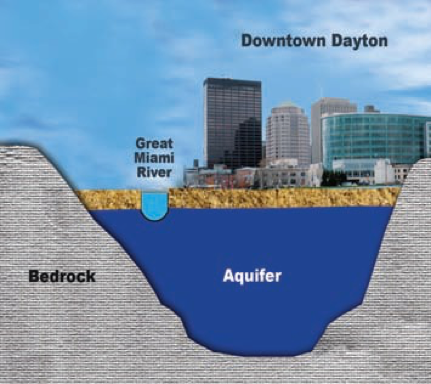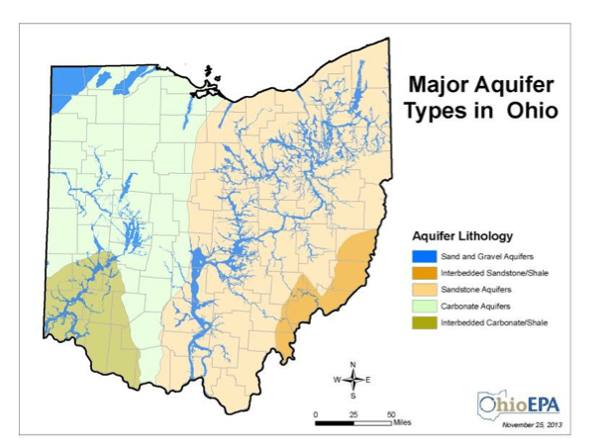Groundwater supplies about 40% of the nation’s drinking water. It's especially important in rural areas, but even urban areas may depend on groundwater to meet a significant portion of daily needs. Groundwater, unlike surface water in streams and lakes, is a largely invisible resource because its presence is hidden beneath the Earth's surface. Groundwater is not evenly distributed and is available in greater quantities in some areas than in others.
Aquifers are the rocks and layers of sediments, such as sand and gravel, through which significant quantities of water can flow to wells. In Ohio the aquifers that can supply the most water to wells are sand and gravel deposits infilling buried valleys. Many of the larger streams in eastern and southwestern Ohio are situated atop thick deposits of sand and gravel, which accumulated as ancient stream deposits partially filled deep valleys carved into the underlying bedrock. One such buried valley underlies the Great Miami River (Figure 1). The sand and gravel aquifer filling this buried valley supplies all the drinking water for the city of Dayton.

Figure 1: The Great Miami River and buried valley at Dayton, Ohio. The sand & gravel filling the deep valley carved into bedrock supplies drinking water for the entire city.
Buried valley fills are the most productive aquifers in Ohio. Bedrock aquifers such as sandstone commonly can sustain water well pumping rates in the range of 5-20 gallons/per minute. Although sufficient to supply a single family home, water wells in bedrock aquifers are unable to supply the vast volumes of water required by the municipal water systems of cities such as Dayton. Water wells supplying city systems typically must be able to sustain pumping rates of 1,000 gallons/minute or higher.
In addition to Dayton, two of Ohio's largest cites Columbus and Cincinnati pump large quantities of groundwater from underlying buried valley aquifers. Unlike Dayton, these cities however utilize both groundwater and surface water drawn from rivers and/or reservoirs to meet their needs. Figure 2 below shows the branching patterns of buried valley, sand and gravel aquifers in Ohio.
 Figure 2: Branching patterns shown in blue on the map are sand & gravel-filled buried valleys. These aquifers are important sources for groundwater for municipal water systems. In the area of Hocking College, towns along the Hocking River valley are solely dependent on these aquifers.
Figure 2: Branching patterns shown in blue on the map are sand & gravel-filled buried valleys. These aquifers are important sources for groundwater for municipal water systems. In the area of Hocking College, towns along the Hocking River valley are solely dependent on these aquifers.
Although smaller than the buried valleys in the Columbus or Cincinnati areas, the sand and gravel-filling the buried valley beneath the Hocking River supplies all the drinking water for towns of Athens, Logan, Lancaster, and Nelsonville.



